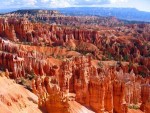Title
The colors, beauty, and grandeur of Utah’s magnificent canyons will light up the Peter Jay Sharp Theater on February 27 when the Axiom Ensemble—a student-managed performing group at Juilliard devoted to performing seminal works of the 20th and 21st centuries—performs Olivier Messiaen’s Des canyons aux étoiles. This concert marks the group’s return to Lincoln Center after its well-received performances of Elliott Carter’s opera What Next? at Columbia University’s Miller Theater in December.
Body
Approached by Alice Tully in 1971 to write a work in honor of the upcoming American bicentennial, Messiaen (1908-1992) researched possible sources of inspiration until focusing his attention on Utah’s Bryce Canyon, Cedar Breaks, and Zion Park. During his visit to the sites, Messiaen transcribed birdsongs and wrote down descriptions of the canyons’ colors, plants, and scents. He then poured his impressions into this tone poem, which was premiered in Alice Tully Hall in 1974 by conductor Frederic Waldman and the Musica Aeterna Orchestra. In spite of the work’s close ties to Lincoln Center, it has not been performed in New York City since the 2001 Lincoln Center Festival. Axiom’s performance offers a fitting tribute to Messiaen during 2008, the composer’s centennial year.
The massive work’s 12 movements are grouped into three large sections: the first and third parts, consisting of five movements apiece, surround the middle part’s two movements, forming a balanced structure. Orchestrated for solo piano, horn, xylorimba, glockenspiel, and orchestra, Des canyons aux étoiles poses formidable challenges to the performers. The parts are technically demanding not only for the soloists, but also for the members of the orchestra.
Messiaen explored many styles and techniques of composition over the course of his career, as discussed by Paul Griffiths in his entry on the composer for New Grove Dictionary of Music. During his early years, Messiaen wrote many works for organ and developed his modes of limited transposition. After becoming a P.O.W. in 1940, he composed Quator pour la fin du temps for piano, violin, clarinet, and cello for fellow prisoners at the camp in Silesia, Germany. The movement titled Danse de la fureur, pour les sept trompettes offers an example of Messiaen’s driving rhythmic blocks. In the late ’40s, he briefly tested the procedures of total serialism before combining these techniques with others. He was an avid ornithologist, and bird calls became another important musical influence, as demonstrated in his 1956-58 piano collection, Catalogue d’oiseaux.
An example of a later work, Des canyons aux étoiles incorporates elements of many of Messaien’s earlier compositions. According to Axiom’s music director, Jeffrey Milarsky, the “sumptuously romantic” work exploits Messiaen’s “special effects, harmonic systems, and bird calls.” Although the tone poem is a “return to the sonorities of his youth,” he said in an interview, "it features extended techniques and exotic instrumentation." For instance, the trumpeters use “wawa” mutes, the pianist creates resonance by pressing the keys silently, and the horn player creates sounds using only the mouthpiece. A wind machine and an “earth machine” (built here at Juilliard years ago, specifically for this piece) play prominent roles.
Messiaen had a mild case of synesthesia, and he explained the following to Harriet Watts in an interview published in the quarterly music journal Tempo in March 1979: “Colours are very important to me because I have a gift—it’s not my fault, it’s just how I am—whenever I hear music, or even if I read music, I see colours. They correspond to the sounds, rapid colours which turn, mix, combine and move with the sounds.” Later in the interview, he remarked, “Bryce Canyon was of special interest to me. That’s because it had all those wonderful colours, and I wanted to put them into music. So, the piece I composed about Bryce Canyon is red and orange, the colour of the cliffs.”
Each movement of the work bears a descriptive title, such as Le désert (“The Desert”), Bryce Canyon et les rochers rouge-orange (“Bryce Canyon and the Red-Orange Rocks”), and Le Moqueur polyglotte (“The Mockingbird”). Though the special effects, exotic instrumentation, and birdsongs evoke the colors and sounds of the canyons, Milarsky notes that the symphonic work is not meant to be an exact portrayal of Utah so much as an illustration of Messaien’s “own wild imagination …” Indeed, the composer was, in Milarsky’s words, an “experienced dreamer.”





